Overview
This class of fruits includes lemons, limes, oranges and grapefruit, as well as many more hybrids and varieties. Fruits in the citrus family grow on evergreen trees or shrubs. They have fairly thick skins and pulpy flesh that’s divided into segments. The peel, or rind, of the fruits is leathery and studded with oil glands.
Here are some popular varieties of citrus fruits:
- Sweet oranges:Valencia, navel, blood orange, cara cara
- Mandarins:Satsuma, clementine, tangor, tangelo
- Limes:Persian, key lime, kaffir
- Grapefruit:White, ruby red, oroblanco
- Lemons:Eureka, Meyer
- Other kinds:Citron, sudachi, yuzu, pomelos
Types of Citrus Fruits
1. Kaffir Lime

Kaffir limes are not true limes, though they are a member of the true citrus family. They are unique to common limes in their shape, texture, fragrance and flavor. Their appearance is memorably ovate with a rounded bottom and conical stem end. The peel is rough, pebbled and filled with essential oils that give the lime its trademark aroma. The juice of the flesh is extremely tart and often bitter, thus it is seldom used in cooking. Kaffir Limes are available in spring with a peak season in fall.
2. Sour/Bitter Orange
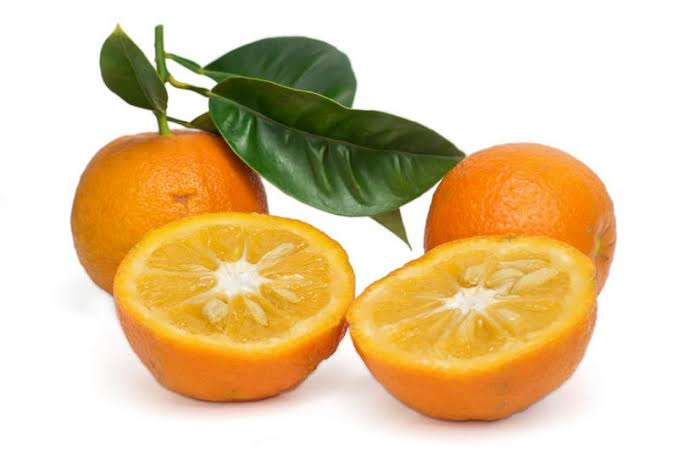
Sour oranges are small to medium in size, averaging 7-8 centimeters in diameter, and are round to oval in shape. The rough skin transitions from green when young to red-orange when mature and is thick, aromatic, wrinkly, and bitter with small oil glands that create a slightly bumpy texture. Underneath the skin, the pale orange flesh is firm, contains a few to many small, inedible seeds, and is divided into 10-12 segments by thin, white membranes. With maturity, the center of the flesh may also become hollow. Sour oranges are juicy and acidic with an extremely bitter taste.
3. Fremont Tangerines

Fremont tangerines are small to medium fruits, averaging 5 to 7 centimeters in diameter, and have a round to oblate shape with a slightly flattened stem end. The peel is semi-thin, dark orange with red undertones, firm, and smooth with a slightly bumpy texture created from prominent oil glands. The peel is easily removed in sections, emitting a fragrant citrus aroma when torn, revealing dark orange flesh divided into 8 to 9 segments by thin membranes.
The flesh is also easily separated into pieces, bearing a soft, tender, and aqueous consistency with a few to many cream-colored seeds. Fremont tangerines have a balanced blend of sugar and acidity, creating a bright and refreshing, sweet, tangy, and tart flavor. Fremont tangerines are available in the winter through early spring.
4. Pomelo

The largest of all citrus fruits, the pomelo is slightly round or pear-shaped. Greenish to yellow to pinkish, it’s wrapped in a very thick skin and may be five to ten inches in diameter. Ranging from the size of a baby cantaloupe to almost basketball size, this fruit can weigh several pounds.
The pulp may be rich pink, pale pink, light yellow or whitish and varies in taste from one variety to another. It may be juicy or a bit dry, acidic to sweet and seedy to nearly seedless. No matter what, however, they are never bitter. Pomelo season begins in the fall and continues into April or May.
Also Read: Different Types of Kales
5. Blood Orange
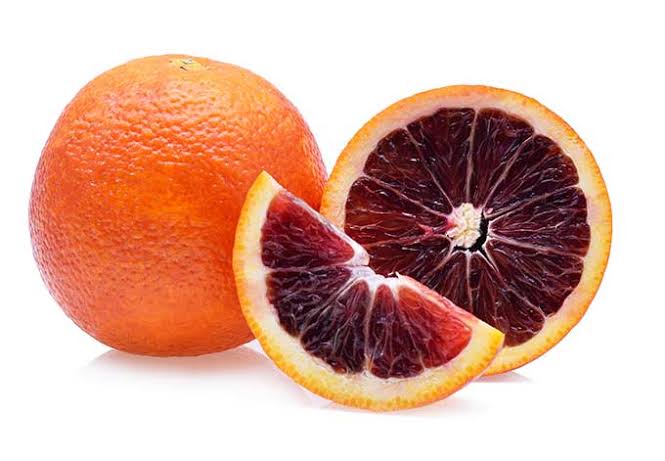
The Blood orange looks like the conventional orange on the outside, with a bright orange outer skin. The inner flesh is where the Blood orange get its name, due to the deep red streaked pulp. The Blood orange offers a sweet aroma and flavor with moderate tart undertones. Blood oranges are available in the winter and throughout the early spring months.
6. Bergamotto lemons

Bergamotto lemons are round and a bit larger than an orange, with a slight pear shape. The green skin of the Bergamotto lemon is thin and very aromatic, which is a result of high amounts of a compound called limonene present in the peel. The skin slowly changes from lime green to a greenish yellow color towards the end of the season. The flesh of the Bergamotto lemon resembles that of a grapefruit, and has a fragrant aroma. The taste of the juice is bitter, acidic, and somewhat musty.
7. Grapefruit
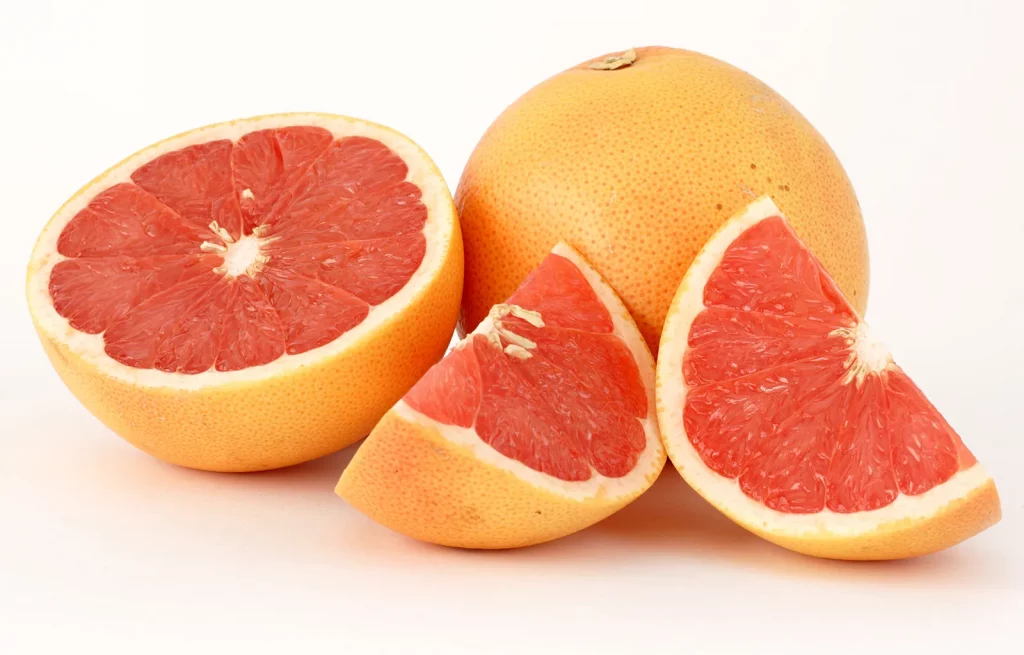
Grapefruits are medium to large fruits, averaging 10 to 15 centimeters in diameter, and are round to ovate, sometimes displaying a slightly flattened appearance. The peel is generally smooth, glossy, and semi-thin with a lightly pebbled texture, covered in small oil glands that release fragrant, essential oils. The peel also generally ripens from green to pale yellow, golden yellow, to yellow-orange blushed with pink, depending on the variety, but some green spots may remain on the surface at maturity for yellow-fleshed varieties and are not indications of ripeness.
Underneath the peel, a thick, white, bitter, and spongy pith is tightly adhered to the flesh, and tough membranes divide the flesh into 10 to 14 segments. The flesh has a translucent hue, ranging in color from pale yellow, pink, to dark red, and is comprised of tiny sacs filled with juice, creating an aqueous, tender, and semi-firm consistency.
Grapefruit varieties will vary in seed content, fluctuating from containing many cream-colored seeds to being found seedless. The flesh’s core may also appear hollow or solid, primarily determined by variety and growing conditions. Grapefruits have a subtle, floral fragrance with a bright, sweet, acidic, and tangy, mildly bitter flavor.
8. Persian Lime

The Persian lime is the variety most commonly found in grocery stores. It is usually seedless and has light-green to a yellow pulp which is tender and acidic, yet lacking the distinctive bouquet of the Key lime. It can be used interchangeably for the same purposes as Key limes and lemons and is often used as a substitute for vinegar. Lime juice may be used to clean lime deposits from the interiors of coffee pots and tea kettles. Homeopathically, lime juice has also been used effectively to relieve the effects of stinging coral.
Also Read: Varieties of Pineapples
9. Key Lime
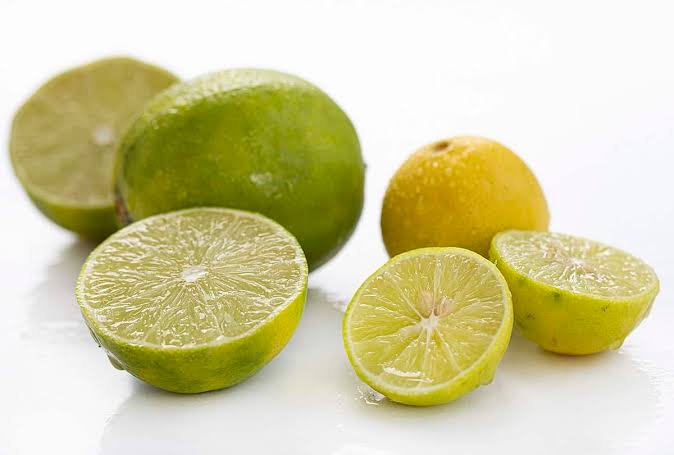
The Key lime is a petite lime that is also known as the Mexican and West Indies lime. The limes are 1 1/2 inches in diameter and their outer skin varies from a kelly green to a light yellowish green, is about the size of a golf ball and has very few seeds. The inner flesh of the Key lime is very juicy and offers a unique sweet-tart flavor that distinguishes this lime from other varieties. Key limes are available in the late summer and throughout the early winter.
10. Kumquat

Kumquats are small fruits, averaging 2 to 5 centimeters in length, and have an oval, round to oblong shape. The fruit’s skin is thin, ripening from green to golden yellow, orange, or red-orange, depending on the variety, and has a glossy, taut appearance with prominent oil glands scattered across the surface. The skin also clings tightly to the flesh, and there is little to no bitter white pith present in the fruit.
The flesh is divided into 3 to 6 segments and is semi-aqueous and tender, encasing a few cream-colored seeds. Kumquats are a unique citrus as the entire fruit is edible, including the peel, flesh, and seeds. The fruit’s peel is sweet, subtly floral, and fruity, balancing the tart, sour taste of the flesh, creating an intense sweet-tart combination with a zesty, citrus zing.
11. Meyer Lemon

Meyer lemons are a small to medium variety, averaging 6 to 8 centimeters in diameter, and have a round to oval shape. The peel is thin, smooth, glossy, golden yellow to orange, and aromatic, lightly textured with glands that release essential oils. Underneath the peel, there is a thin and spongy white pith enveloping yellow-orange flesh, divided into 9 to 10 segments by white membranes.
The flesh is also soft, tender, and aqueous, encasing a few seeds or being found seedless. Meyer lemons are highly fragrant and emit a bright, herbal scent with subtle spice-filled notes. The fruits also contain low acidity and a high sugar content, developing a sweet, zesty flavor with floral undertones. Meyer lemons are available year-round, with a peak season in the early winter through the spring.
Also Read: Different Types of Lemons
12. Bergamot Orange

Bergamot oranges are small to medium in size, averaging 6-8 centimeters in diameter, and are globular to obovoid in shape. The glossy rind matures from green to bright yellow and has a smooth, pebbled texture from visible oil glands strewn across the surface. Underneath the rind, the pith is white, spongy, and semi-thick with a cotton-like texture.
The flesh is soft, pale-yellow, and is divided into 8-14 segments by thin, white membranes. It also contains a few, cream-colored seeds and has a very acidic, tart, and bitter taste, which makes it generally unsuitable for fresh eating. Bergamot oranges are known for their aromatic rind that is full of essential oils that have fresh, floral notes mixed with bright citrus undertones. Bergamotto lemon, or Bergamot citrus, is available in the fall through the spring.
13. Mandarin Orange
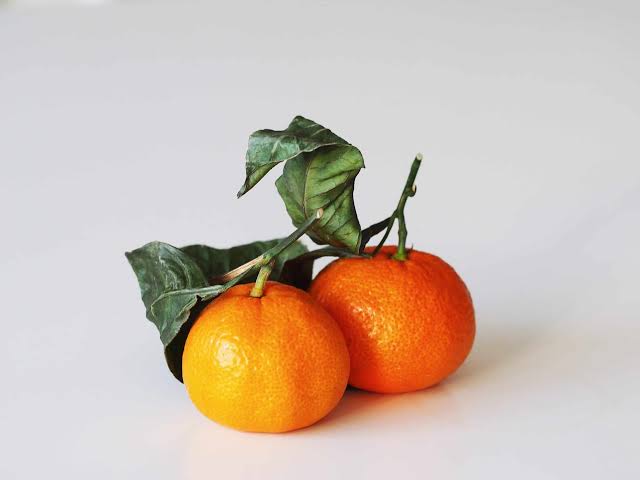
The fruit is oblate, the peel bright-orange or red-orange when ripe, loose, separating easily from the segments. Seeds are small, pointed at one end, green inside. Mandarin oranges are much more cold-hardy than the sweet orange, and the tree is more tolerant of drought. The fruits are tender and readily damaged by cold.
Mandarin oranges are commonly eaten fresh or may be processed for canned segments. They can be pressed or squeezed to produce juice which is used in many beverages. Mandarin essential oil is used as a flavoring in alcoholic drinks.
14. Tangerine

Tangerines are generally small and flatter than most other citrus. They have dark orange skin that sits loosely on the flesh inside, so they are easy to peel. The flesh is divided into eight to ten segments, which contain juicy and extremely sweet fruit, without the usual acidity of most citrus. Tangerines are available beginning to late winter.
Since tangerines are so easy to peel, they are a great choice for on-the-go snacks or children’s lunches. Enjoy them as is, or in baked goods, jams, and other desserts. The juice is very sweet and refreshing, while the skin can be candied. Choose fruit that is firm and bright in color rather than soft and dull, and that feels heavy. They store best in the refrigerator for up to a week.
15. Tangelo
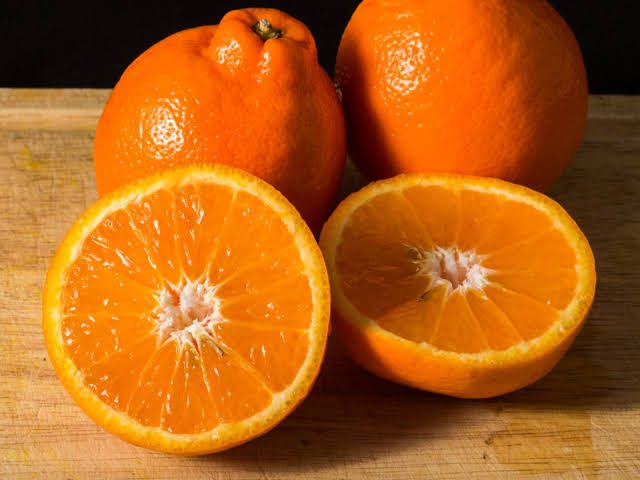
Tangelos are large fruits, averaging 7 to 9 centimeters in diameter, and have a round to oblate shape with a pronounced, elongated neck on the stem-end. The rind is thin, glossy, bright red-orange, and has a smooth and lightly pebbled, textured surface, created from many prominent oil glands.
The rind is also easily peeled, revealing 10 to 12 segments of orange, soft, and aqueous flesh, and the flesh is either seedless or found with a few cream-colored seeds. Minneola tangelos have a sweet-tart flavor with the tangy, floral acidity of grapefruit mixed with the fragrant, honeyed flavor of tangerines. Tangelos are available in the winter through early spring.
Also Read: Types of Mashrooms
16. Ugli Fruit
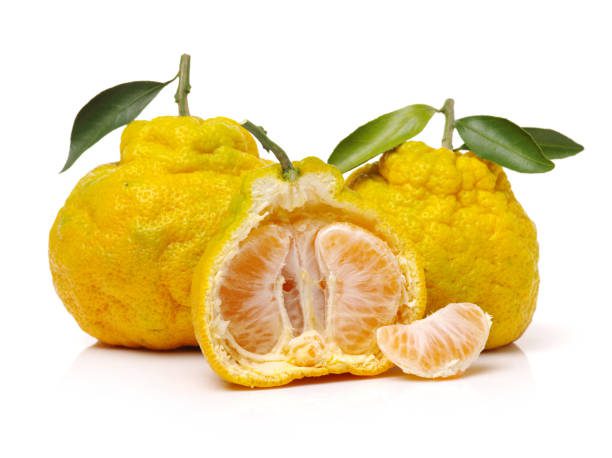
Ugli fruits are a large citrus variety, averaging 10 to 15 centimeters in diameter, and have an irregular, oval to slightly flattened, oblate shape. The peel is semi-thick, leathery, and rough, covered in patches of russet, scars, bumps, and wrinkles. The fruits are available for a limited season in the winter through early spring.
The fruits also bear variegated hues of green, yellow, and orange, and as the fruit matures, it will develop deeper yellow-orange shades, sometimes retaining green spots. It is important to note that green is not an indication of unripe fruit. The peel loosely clings to the flesh, easily removed, and the flesh is divided into 10 to 12 large segments, separated by fibrous membranes.
The flesh also ranges in color from yellow to orange and is tender, aqueous, and succulent, either being found seedless or encasing a few cream-colored seeds. Ugli fruits are aromatic with a light, lemon-like fragrance and have a sweet, subtly tangy flavor with fruity notes of pineapple, grapefruit, and oranges.
17. Yuzu Limes
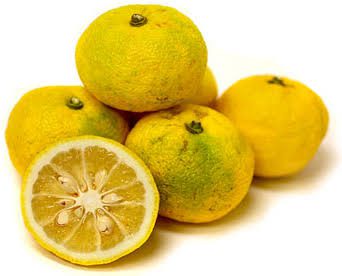
Yuzu limes are small, slightly flattened fruits, averaging 5 to 10 centimeters in diameter, and are round, oblate, to lopsided in shape. The peel is thick, pebbly, and rough, pocked with many prominent oil glands and pores, and matures from dark green to golden yellow. Underneath the peel, the yellow flesh is minimal but juicy, divided into 9 or 10 segments by white membranes, and is filled with many large, inedible cream-colored seeds.
Yuzu limes are highly aromatic, and the rind is rich in essential oils that are released when the fruit’s surface is scratched or cut. The juice and zest have a unique, acidic blend of sour, sweet, and floral flavors mixed with notes of lime, grapefruit, mandarin. Yuzu limes are available in the winter through early spring.
18. Clementine

Clementines are small to medium fruits, averaging 5 to 10 centimeters in diameter, and vary in shape from round, sometimes slightly flattened, to oblate. The skin is thin, bright orange to orange-red, and semi-smooth, ranging from glossy, leathery, to faintly textured due to prominent oil glands.
The skin is also easily peeled from the flesh, emitting an aromatic and bright, floral scent when torn, revealing a thin layer of white pith. The pith does not cling to the flesh, and the orange flesh is divided into 7 to 14 segments by thin membranes.
The flesh is semi-aqueous, tender, and soft, either being found seedless or containing a few cream-colored seeds. Clementines have balanced sugar and acidity levels, creating a noticeably sweet, subtly tangy flavor with fruity and floral nuances. Clementines are available year-round, with a peak season in the late fall through mid-winter.
Also Read: Different Types of Pumpkin
19. Sweet Lime

Sweet limes are small in size, averaging 5-7 centimeters in diameter, and are round to oblate in shape. The rind is thin, easy-to-peel, smooth, covered in visible oil glands, and depending on the climate, may remain green when ripe or mature to a golden-yellow.
Underneath the rind, the flesh is soft, yellow-green, divided into ten segments by thin, white membranes, and contains a few, inedible, cream-colored seeds. Sweet limes are aromatic, juicy, and have low acidity creating a palatable, mild, and sweet flavor with subtle honey notes. Sweet limes are available in the late fall through winter.
20. Buddha’s Hand Citron
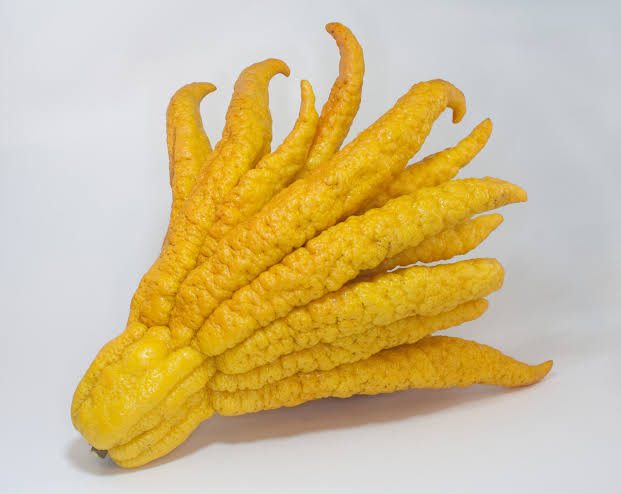
Buddha’s Hand citron widely varies in size, shape, and appearance, depending on growing conditions and specific type. The fruit begins small with an oval to oblong shape and is a purple-brown hue. As it matures, the fruit transitions to golden yellow, and the non-stem end separates and extends into elongated, finger-like segments.
The rind of the citron is textured, bumpy, and covered in small oil glands that release an aromatic scent reminiscent of lemon and lavender. The rind also has a bitter-sweet, citrus-forward flavor. Underneath the rind, the flesh is generally void of juice, seeds, and pulp and only contains a thick and spongy, white pith that bears a sweet flavor.
Buddha’s Hand citron has a bitter-sweet, bright and floral flavor that is primarily used as a zest for flavoring sweet and savory applications. Buddha’s Hand citron is available in late fall through early winter. In some temperate climates, trees will produce fruit sporadically year-round.
Also Read: Difference Between True And False Fruit
21. Gold Nugget Tangerines
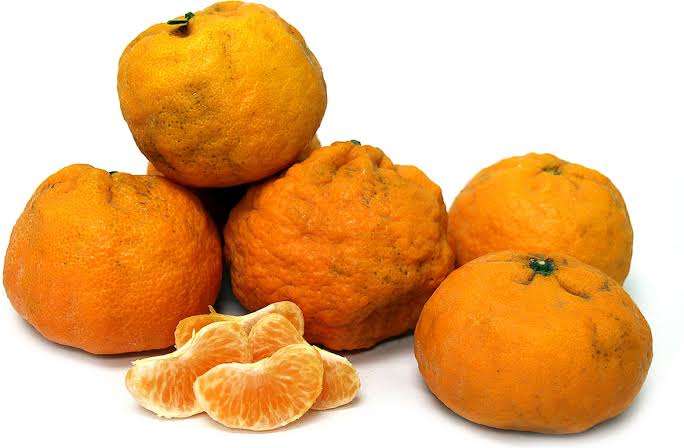
Gold Nugget tangerines are a medium to large variety, averaging 5 to 8 centimeters in diameter, and have a slightly flattened, oblate to round shape without a distinct neck. The pale to golden-orange fruits have a textured surface, ranging from glossy and finely pitted with depressed oil glands to semi-coarse and externally bumpy, depending on the cultivation methods used and tree maturity.
The rind is also somewhat easy-to-peel, releasing bursts of fragrant oils when torn. Once removed, it reveals a bright orange flesh divided into 9 to 10 segments by thin, white membranes. The flesh is soft, tender, aqueous, and mostly seedless. Gold Nugget tangerines have high sugar content balanced by mild acidity, creating a sweet, fruity, and subtly tangy flavor. Gold Nugget tangerines are available in the late winter through early summer.
22. Calamondin Lime

Calamondin limes are small fruits, averaging 2 to 5 centimeters in diameter, and are globular to oblate in shape. The skin is smooth, thin, glossy, and taut, covered in many small, prominent oil glands, and ripens from green, yellow, to orange with maturity. Depending on the climate and region grown, the fruit may also remain green when ripe. Underneath the surface, the flesh is orange, aqueous, soft, and divided into 7 to 9 segments by thin, pale orange membranes.
The flesh also encases many small, cream-colored seeds. Calamondin limes are aromatic with a bright, floral scent and have a tart, pleasantly sour, and acidic citrus taste. It is important to note that both the flesh and peel are edible, and the peel contains a tangy, slightly sweeter taste than the flesh. Calamondin limes are available year-round, with a peak season in the winter through spring.
23. Navel Orange

Navel oranges are medium to large in size, averaging 6-10 centimeters in diameter, and are globular to slightly oval in shape with the trademark “navel” or circular hole on the blossom stem end. The medium-thick rind matures from green to bright orange and is smooth with a pebbled texture due to many oil glands found across the surface. Underneath the outer layer of the rind, the white pith clings to the flesh, but is easily peeled and has a spongy texture.
The pale yellow-orange flesh is juicy, tender, seedless, and divided into 10-12 segments by thin membranes. Navel oranges are aromatic, sweet, and contain a low-acidity which produces a balanced level of sweet, tangy, and tart flavors. Navel oranges are available in the winter through spring.
24. Calamondin Orange
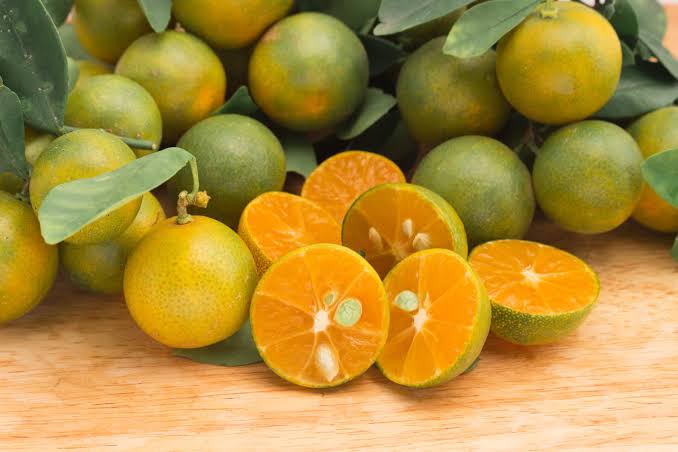
The small Calamondin orange has a bright orange skin with a small green notch at the top, a remnant of the harvest. First cultivated in China, the Calamondin orange is a little larger than a quarter and typically does not exceed one inch in diameter. The rind is thin, easy to peel and reveals an extremely juicy flesh. Calamondin oranges have a lot of flavor for its small size, offering an especially sour tangy flavor. Calamondin oranges are available year-round, due to its hardiness and tolerance to low temperatures.
Further References
- Citrus Fruit: https://en.m.wikipedia.org/wiki/Citrus
- Citrus fruits: https://www.newworldencyclopedia.org/entry/Citrus
- Citrus fruits: https://www.fao.org/markets-and-trade/commodities/citrus/en